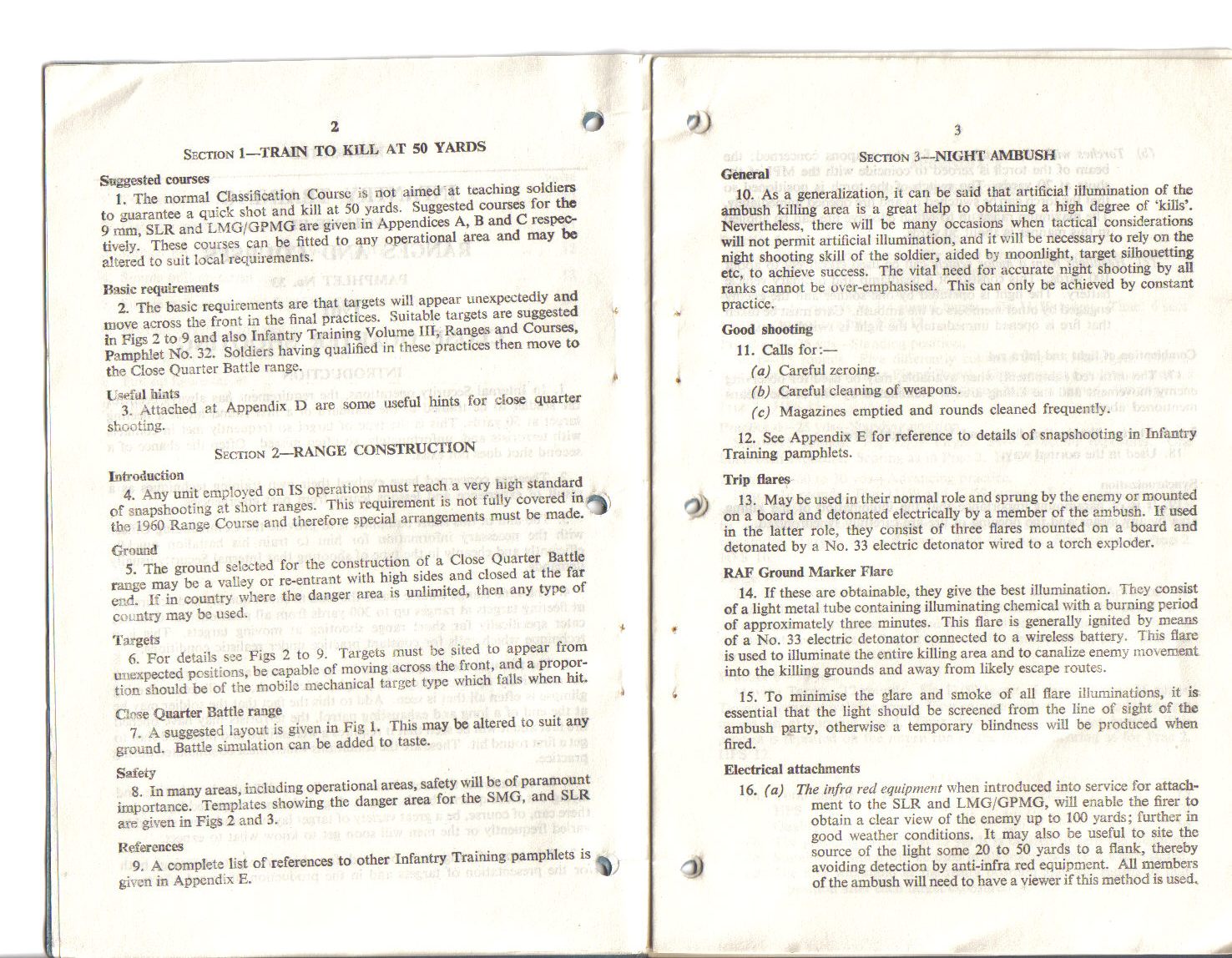CQS03

n
2
Section 1—TRAIN TO K1LL AT 50 YARDS
Suggested courses
1. The normal Classification Course is not aimed at teaching soldiers to guarantee a quick shot and kill at 50 yards. Suggested courses for the 9 mm, SLR and LMG/GPMG are given in Appendices A, B and C respec-tiveiy. These courses can be fitted to any operational area and may be akered to suit local reąuirements.
Basic retjuiremenłs
2. The basie requirements are that targets will appear unexpectedly and move across the front in the finał practices. Suitable targets are suggested in Figs 2 to 9 and also Infantry Training Volume III, Ranges and Courses, Pamphlet No. 32. Soldiers having qualified in these practices then move to the Close (Juarter Battle rangę.
Lseful hints
3. Attached at Appcndix 13 are some useful liints for close quarter
shooting.
Section 2—RANGĘ CONSTRUCTION
titroduction
4. Any unit employed on IS operations must reach a very high standard
of snapshooting at short ranges. This requirement is not fully covcred in ^ the, 1960 Rangę Course and therefore special arrangements must be madę. *
Grnand
5. The ground selected for the construction of a Close Quarter Battle rangę may be a valley or re-entrant with high sides and closed at the far er.d. If in country where the danger area is unlimited, then any type of country may be used.
Targets *
6. For details see Figs 2 to 9. Targets must be sited to appear from unexpected pesitions, be capable of moving across the front, and a propor-tion should be of the mobile mechanical target type which falls when hit.
Ciese Qnarter Battle rangę
7. A suggested layout is given in Fig 1. This may be altered to suit any ground. Battle simulation can be added to taste.
Safety
8. In many areas, including operational areas, safety will be of paramount importance. Templates showing the danger area for the SMG, and SLR
are given in Figs 2 and 3.
Refercnces
9. A complete list of references to other Infantry Training pamphlets is
givcn in Appcndix E.
Shction 3—NIGHT AMBUSH
General
10. As a generalization, it can be said tbat artificial illumination of the ambush killing area is a great help to obtaining a high degree of ‘kills’. Nevertheless, there will be many occasions whcn tactical considerations will not permit artificial illumination, and it will be necessary to rely on the night shooting skill of the soldier, aided by moonlight, target silhouetting etc, to achieve success. The vital need for accurate night shooting by all ranks cannot be ovcr-emphasised. This can only be achieved by constant practicc.
Good shooting
11. Calls for :—
(a) Careful zeroing.
(b) Careful cleaning of weapons.
(c) Magazines emptied and rounds cleaned frequent!y.
12. See Appendix E for reference to details of snapshooting in Infantry Training pamphlets.
Trip flares
13. May be used in their normal role and sprung by the enemy or mounted on a board and detonated electrically by a member of the ambush. If used in the latter role, they consist of three flares mounted on a board and detonated by a No. 33 electric detonator wired to a torch expioder.
RAF Ground Marker Flarę
14. If these are obtainablc, they give the best illumination. They consist of a light metal tubę containing illuminating Chemical with a burning period of approximately three minutes. This flarę is generally ignited by means of a No. 33 electric detonator connected to a wireless battery. This flarę is used to illuminate the entire killing area and to canalize enemy mo\ement into the killing grounds and away from likely escape routes.
15. To minimise the glare and smoke of all flarę iliuminations, it is essential that the light should be screened from the linę of sight of the ambush party, otherwise a temporary blindness will be produced when fi red.
Electrical attachmcnts
16. (a) The Infra red eąuipment when introduced into service for attach-
ment to the SLR and LMG/GPMG, will enable the firer to obtain a elear view of the enemy up to 100 yards; further in good weather conditions. It may also be useful to site the source of the light some 20 to 50 yards to a flank, thereby avoiding detection by anti-infra red eęuipmcnt. All merabers of the ambush will need to have a viewer if this method is used.
Wyszukiwarka
Podobne podstrony:
Backing Up Your Database This section describcs how to back up your database with RMAN. The Oracle s
m85@ examples of these are illustrated in the tapestry but it is not possible to interpret the
redsnOw 0.9.6b5 Please make surę your device is both OFF and PLUGGED IN to the Computer If it is not
Suzuki RM125? CYLINDER, PISTON AND EXH AUST VALVE 6-11 _CAUTION_ If the piston pin end is not at the
23844 pg048 Sleeves This section concentiates on three types of steeve: seevcs set mto the normal bo
Antoine? Saint Exupery quotes (6) ”jAs boż the fautuże, youZ task is not to frotesee it, but to ena
skanuj0019 (295) V , o o O Q % ^. C <r O o> a o c ofam* 1® tr $>i^v = t?in*>
Zdjęcie0273 1. Pituicyty to komórki: (ąT) gkjcrwe przysadki; o) glejowe szyszynki; C) pielęgnujące”
ss 025 A PHYSIQUE TO BE PROUD OF—SHOWS YOU WHAT TO EXPECT AT THE END OF THE SIX MONTHS COURSE Posiał
img002 Reąuirements:Tatting Skills assumed: The reader should bc able to tat at a beginner level, in
więcej podobnych podstron